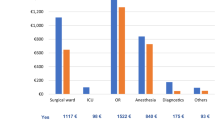Abstract
Background
Surgically treatable diseases contribute approximately 11% of disability-adjusted life years (DALYs) worldwide yet they remain a neglected public health priority in low- and middle-income countries (LMICs). Pediatric inguinal hernia is the most common congenital abnormality in newborns and a major cause of morbidity and mortality yet elective repair remains largely unavailable in LMICs. This study is aimed to determine the costs and cost-effectiveness of pediatric inguinal hernia repair (PIHR) in a low-resource setting.
Methods
Medical costs of consecutive elective PIHRs were recorded prospectively at two centers in Uganda. Decision modeling was used to compare two different treatment scenarios (adoption of PIHR and non-adoption) from a provider perspective. A Markov model was constructed to estimate health outcomes under each scenario. The robustness of the cost-effectiveness results in the base case analysis was tested in one-way and probabilistic sensitivity analysis. The primary outcome of interest was cost per DALY averted by the intervention.
Results
Sixty-nine PIHRs were performed in 65 children (mean age 3.6 years). Mean cost per procedure was $86.68 US (95% CI 83.1–90.2 USD) and averted an average of 5.7 DALYs each. Incremental cost-effectiveness ratio was $12.41 per DALY averted. The probability of cost-effectiveness was 95% at a cost-effectiveness threshold of $35 per averted DALY. Results were robust to sensitivity analysis under all considered scenarios.
Conclusion
Elective PIHR is highly cost-effective for the treatment and prevention of complications of hernia disease even in low-resource settings. PIHR should be prioritized in LMICs alongside other cost-effective interventions.


Similar content being viewed by others
References
Kingsnorth AN, Clarke MG, Shillcutt SD (2009) Public health and policy issues of hernia surgery in Africa. World J Surg 33(6):1188–1193. doi:10.1007/s00268-009-9964-y
Grosfeld JL (1989) Current concepts in inguinal hernia in infants and children. World J Surg 13(5):506–515. doi:10.1007/BF01658863
Kapur P, Caty MG, Glick PL (1998) Pediatric hernias and hydroceles. Pediatr Clin North Am 45(4):773–789
Bickler SW, Rode H (2002) Surgical services for children in developing countries. Bull World Health Organ 80(10):829–835
Debas HT, Gosselin R, McCord C (2006) Disease control priorities in developing countries. Oxford University Press, p 16
Petroze RT et al (2013) Estimating operative disease prevalence in a low-income country: results of a nationwide population survey in Rwanda. Surgery 153(4):457–464
Weiser TG et al (2008) An estimation of the global volume of surgery: a modelling strategy based on available data. The Lancet 372(9633):139–144
Walker IA et al (2010) Paediatric surgery and anaesthesia in south-western Uganda: a cross-sectional survey. Bull World Health Organ 88(12):897–906
Bellagio report: conference on increasing access to surgical services in resource-constrained settings in sub-Saharan Africa, summary report. 2007: Bellagio, Italy
McCord C, Chowdhury Q (2003) A cost effective small hospital in Bangladesh: what it can mean for emergency obstetric care. Int J Gynaecol Obstet 81(1):83–92
Shillcutt SD, Clarke MG, Kingsnorth AN (2010) Cost-effectiveness of groin hernia surgery in the Western Region of Ghana. Arch Surg 145(10):954–961
Tan-Torres Edejer T et al (2003) Making choices in health: who guide to cost-effectiveness analysis. World Health Organisation, Geneva
International drug price indicator guide. Management Sciences for Health [cited 2011 January 7]; Available from: http://erc.msh.org/dmpguide/index.cfm?search_cat=yes&display=yes&module=dmp
AFRO Essential Medicines Price Indicator. 2003 [cited 2011 July 1]
Mulligan J et al (2005) DCPP Working Paper No. 9—Unit Costs of Health Care Inputs in Low and Middle Income Regions, in Disease Control Priorities Project
Gosselin RA, Thind A, Bellardinelli A (2006) Cost/DALY averted in a small hospital in Sierra Leone: what is the relative contribution of different services? World J Surg 30(4):505–511. doi:10.1007/s00268-005-0609-5
World Health Organization Choosing Interventions That Are Cost-effective. WHO-CHOICE. [cited 2010 November 7]; Available from: http://www.who.int/choice/en/
World Data Bank-World Development Inidcators and Global Development Finance. [cited 2011 July 1]; Available from: http://databank.worldbank.org/ddp/home.do?Step=12&id=4&CNO=2
Murray CJ (1994) Quantifying the burden of disease: the technical basis for disability-adjusted life years. Bull World Health Organ 72(3):429–445
Fox-Rushby JA, Hanson K (2001) Calculating and presenting disability adjusted life years (DALYs) in cost-effectiveness analysis. Health Policy Plan 16(3):326–331
Life tables for WHO Member States: Uganda. [cited 2011 July 1]; Available from: http://www.who.int/healthinfo/statistics/mortality_life_tables/en/
Global Burden of Disease 2004 Update: Disability weights for diseases and conditions. Global Burden of Disease Project 2004 [cited 2011 April 1, 2011]; Available from: http://www.who.int/healthinfo/global…disease/GBD2004_DisabilityWeights.pdf
Medical Services Commission—Payment Schedule. [cited 2011 July 7]; Available from: http://www.health.gov.bc.ca/msp/infoprac/physbilling/payschedule/index.html
Brandt ML (2008) Pediatric hernias. Surg Clin North Am 88(1):27–43, vii–viii
Kruk ME et al (2007) Economic evaluation of surgically trained assistant medical officers in performing major obstetric surgery in Mozambique. BJOG 114(10):1253–1260
Jha P, Bangoura O, Ranson K (1998) The cost-effectiveness of forty health interventions in Guinea. Health Policy Plan 13(3):249–262
Anand S, Hanson K (1997) Disability-adjusted life years: a critical review. J Health Econ 16(6):685–702
Acknowledgments
The project was supported by unrestricted grants from the Branch of International Surgery at the University of British Columbia and the Office of Pediatric Surgical Evaluation and Innovation.
Conflicts of interests and disclosures
None.
Author information
Authors and Affiliations
Corresponding author
Electronic supplementary material
Below is the link to the electronic supplementary material.
Rights and permissions
About this article
Cite this article
Eeson, G., Birabwa-Male, D., Pennington, M. et al. Costs and Cost-Effectiveness of Pediatric Inguinal Hernia Repair in Uganda. World J Surg 39, 343–349 (2015). https://doi.org/10.1007/s00268-014-2818-2
Published:
Issue Date:
DOI: https://doi.org/10.1007/s00268-014-2818-2




